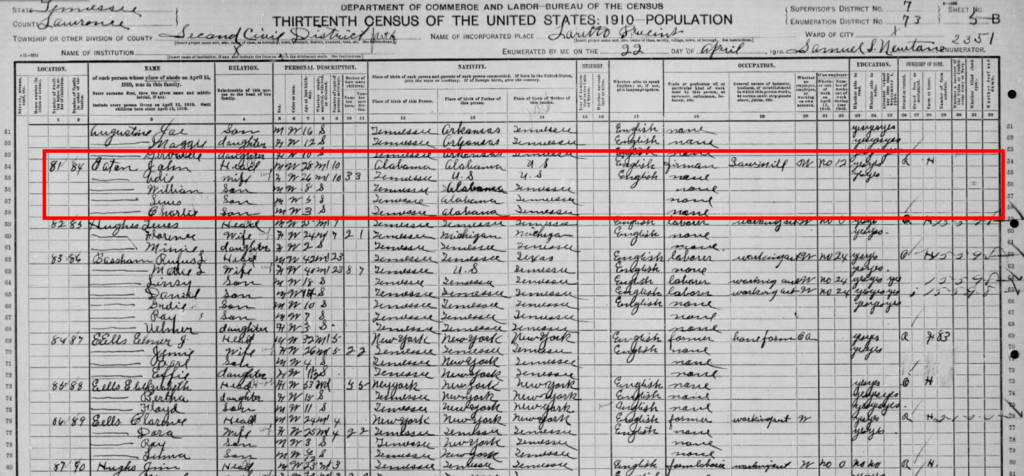The 1910 U.S. census was almost identical to the previous 1900 U.S. census. There were a few differences that collected some new data points. Some questions were similar to the previous census but asked in a slightly different way.
This census was the first to be administered and run by a permanent government agency, the Census Bureau, with full-time employees. Prior to the 1900 U.S. census, employees were temporary. They were also hired by a patronage system meaning your employment was based upon who you were and who you knew. Theodore Roosevelt insisted on requiring candidates take a civil service exam to determine employment eligibility.
This census also saw a release of a questionnaire distributed to people prior to the actual census day. The intent was to encourage individuals to fill out this questionnaire in preparation for the enumerator’s visit and possibly to help save time. Not many people actually filled out the questionnaire flyers, but it did help them know what would be asked.
Table of Contents
Questions for the 1910 U.S. Census
The FamilySearch Research Wiki article for the 1910 U.S. census contains a list of the questions that were asked. Many of the questions were the same as the previous census, with a few differences.
This census asked for the age of the individual rather than a birth month and birth year. The researcher then needs to do the match to determine a birth year. Very often the derived age can be off by a year or two. It seems odd that people did not know the exact age, but birthdays were not the annual celebrations we experience today. Also the reported age may have come from a member of the household who was guessing. It’s important not to get too hung up on differences in the census versus other records. The reported age is just another clue for your ancestor.
The marriage column asked the usual married, single or widowed status. Sometimes you may see M1 or M2 in that column. This often means first marriage or second marriage. It’s not really clear if enumerators were supposed to clarify the number of marriage, but this little tidbit can help clarify potentially unexpected relationships. It may also tell you to look for other marriages for an individual.

Occupational information was further clarified. A person was asked for their trade or profession and then what industry. So for example, they may report their occupation as a day laborer in farming or odd jobs. This information provided additional information on the types of industry in the country and how many individuals were involved in each type.
Almost 50 years had passed since the start of the American Civil War. This census asked if an individual was a survivor of the Civil War, whether Union or Confederate. There were still Civil War veterans alive in 1910, but that population was aging. This question would provide statistical information on how many were still alive.
Data was used from this census to know how many draft-age men were in the country at the start of World War I. The government was also able to evaluate each state’s industrial capacity as it geared up for war.
Missing Records
According to the FamilySearch Research Wiki, all of the states and several territories were included in the 1910 U.S. census. It is possible individual enumeration sheets have gone missing over time.
Statistics
The overall total population of the United States increased about 21% to 92,228,496. The most populous state was New York and the least populous was Nevada. Every state increased in population except for Iowa. The most populous cities were New York City, Chicago, and Philadelphia. (Wikipedia article).
A look at John Henry Eaton

We looked at John Henry Eaton in the 1900 U.S. census.1 In 1900 John Henry and his wife Hautie Lou were newly married with no children. They were living next door to Hautie Lou’s mother Mandy Smith in Lawrence County, Tennessee. There were a few changes over the next 10 years.

By 1910, John Henry and Hautie Lou had three children, William, Robert Louis, and Charlie.2 John Henry and Hautie Lou did not appear to be living next to Hautie’s mother anymore but they were still in Lawrence County, Tennessee. William was 8 years old, Robert Louis 5 years, and Charlie was 3 years old.
John Henry was working as a fireman at a sawmill. We was out of work for 12 weeks in 1909. I imagine life was very difficult with an extremely tight budget. The family was once again living in a rented house. Any picture we have of this family shows evidence of how hard life must have been.
Sources
- 1900 U.S. Census, Lawrence, Tennessee, population schedule, township 2nd District, enumeration district (ED) 50, sheet 7A (penned), dwelling 115, family 121, John H Eaton; digital image, Ancestry, (http://www.ancestry.com accessed 30 Jun 2023); citing NARA microfilm publication T623, roll 1584:
- 1910 U.S. Census, Lawrence, Tennessee, population schedule, township 2nd District, enumeration district (ED) 73, sheet 5B (penned), dwelling 81, family 84, John Eaton; digital image, FamilySearch, (https://www.familysearch.org/ark:/61903/1:1:MGFY-WXG : accessed 29 June 2023); citing NARA microfilm publication T624, roll 1509.







One response to “A good look at the 1910 U.S. Census”
[…] 1920 U.S. Census was very similar to the 1910 U.S. Census. A few questions were eliminated from the previous census and few new ones added. The census day […]